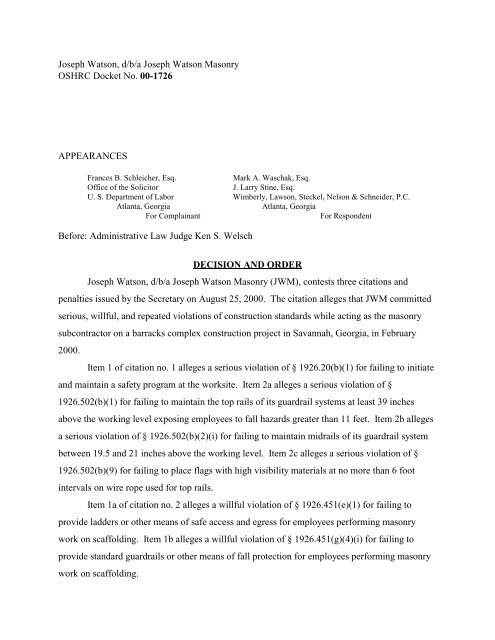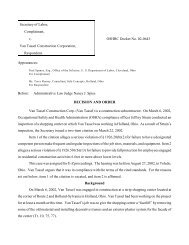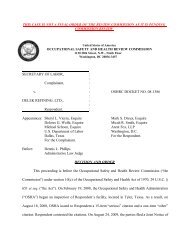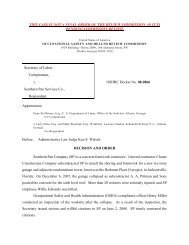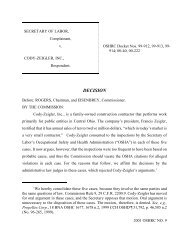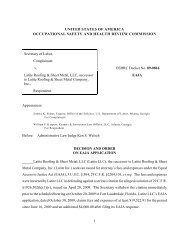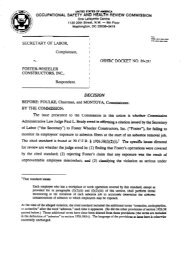Joseph Watson, d/b/a Joseph Watson Masonry - Occupational ...
Joseph Watson, d/b/a Joseph Watson Masonry - Occupational ...
Joseph Watson, d/b/a Joseph Watson Masonry - Occupational ...
Create successful ePaper yourself
Turn your PDF publications into a flip-book with our unique Google optimized e-Paper software.
<strong>Joseph</strong> <strong>Watson</strong>, d/b/a <strong>Joseph</strong> <strong>Watson</strong> <strong>Masonry</strong><br />
OSHRC Docket No. 00-1726<br />
APPEARANCES<br />
Frances B. Schleicher, Esq. Mark A. Waschak, Esq.<br />
Office of the Solicitor J. Larry Stine, Esq.<br />
U. S. Department of Labor Wimberly, Lawson, Steckel, Nelson & Schneider, P.C.<br />
Atlanta, Georgia Atlanta, Georgia<br />
For Complainant For Respondent<br />
Before: Administrative Law Judge Ken S. Welsch<br />
DECISION AND ORDER<br />
<strong>Joseph</strong> <strong>Watson</strong>, d/b/a <strong>Joseph</strong> <strong>Watson</strong> <strong>Masonry</strong> (JWM), contests three citations and<br />
penalties issued by the Secretary on August 25, 2000. The citation alleges that JWM committed<br />
serious, willful, and repeated violations of construction standards while acting as the masonry<br />
subcontractor on a barracks complex construction project in Savannah, Georgia, in February<br />
2000.<br />
Item 1 of citation no. 1 alleges a serious violation of § 1926.20(b)(1) for failing to initiate<br />
and maintain a safety program at the worksite. Item 2a alleges a serious violation of §<br />
1926.502(b)(1) for failing to maintain the top rails of its guardrail systems at least 39 inches<br />
above the working level exposing employees to fall hazards greater than 11 feet. Item 2b alleges<br />
a serious violation of § 1926.502(b)(2)(i) for failing to maintain midrails of its guardrail system<br />
between 19.5 and 21 inches above the working level. Item 2c alleges a serious violation of §<br />
1926.502(b)(9) for failing to place flags with high visibility materials at no more than 6 foot<br />
intervals on wire rope used for top rails.<br />
Item 1a of citation no. 2 alleges a willful violation of § 1926.451(e)(1) for failing to<br />
provide ladders or other means of safe access and egress for employees performing masonry<br />
work on scaffolding. Item 1b alleges a willful violation of § 1926.451(g)(4)(i) for failing to<br />
provide standard guardrails or other means of fall protection for employees performing masonry<br />
work on scaffolding.
Item 1 of citation no. 3 alleges a repeated violation of § 1926.451(c)(2) for failing to erect<br />
a scaffold using base plates and mud sills. Item 2 alleges a repeated violation of § 1926.451(f)(7)<br />
for failing to erect scaffolds under the supervision of a competent person. Item 3 alleges a<br />
repeated violation of § 1926.454(a) for failing to provide safety training in scaffolding.<br />
JWM’s general contractor on the project was Metric Constructors, Inc. The Secretary<br />
issued one citation to Metric arising from the same inspection alleging serious violations of the<br />
construction standards (Docket No. 00-1930, Decision to be filed January 24, 2002).<br />
A consolidated hearing was held in Savannah, Georgia, on January 31, and February 1<br />
and 2, 2001; and in Atlanta, Georgia, on February 15 and 16, 2001. The parties stipulated<br />
jurisdiction and coverage (Tr. 6).<br />
JWM denies the Secretary’s charges and asserts it lacked knowledge of any OSHA<br />
standards being violated by its employees. For the reasons discussed below, item 1 of citation<br />
no. 1, item 1a of citation no. 2, and item 2 of citation no. 3 are vacated. Items 2a, 2b and 2c of<br />
citation no. 1 are affirmed. Item 1b of citation no. 2 is affirmed as serious. Items 1 and 3 of<br />
citation no. 3 are affirmed.<br />
Background<br />
Pursuant to a contract with the United States Army Corps of Engineers (Corps), Metric<br />
began construction in September 1998 of a barracks complex at Hunter Army Air Field in<br />
Savannah, Georgia. Metric hired JWM to perform the masonry and brickwork. Metric’s<br />
contract with the Corps required it to conduct daily inspections (Tr. 82, 100, 145, 404, 561).<br />
Metric had three employees on the site: project superintendent Tony Pittman, chief of quality<br />
control Robert Garcia, and carpenter and brick mason Lucky Caswell (Tr. 44, 243, 316, 831).<br />
The project involved the construction of three three-story barracks buildings (buildings<br />
310, 311, and 313) and a service community building (building 312). Each building is<br />
approximately 60 yards long and 20 yards wide.<br />
Subcontractor JWM began installing the brick exterior on the buildings in August 1999.<br />
JWM owner <strong>Joseph</strong> <strong>Watson</strong> supervised the brick work for the first three months. In December,<br />
<strong>Watson</strong> left the site to start another project in Atlanta. After that, <strong>Watson</strong> visited the site each
month for approximately 2 days. JWM foreman Jesse Fowler supervised JWM’s employees on<br />
the site. JWM had approximately 20 employees (masons and laborers) on the project. Some of<br />
the employees were newly hired through the Savannah newspapers solely for the barracks project<br />
(Tr. 52, 55, 63-64, 340).<br />
The Corps inspected the project daily for progress and quality, as well as for safety<br />
hazards (Exhs. R-1 through R-20). Fred Gotthardt, Corps supervising project engineer,<br />
performed the inspections, assisted by Steve Bentley and Christopher Pruitt (Tr. 79, 402, 476).<br />
When Gotthardt performed the inspections, he was accompanied by Metric’s Pittman or Garcia,<br />
or both. If the inspection involved masonry work, JWM foreman Fowler participated in the<br />
inspection.<br />
Gotthardt found repeated safety problems with the scaffolding and fall protection for the<br />
employees (Exhs. C-4 through C-18). Gotthardt noted the problems in the Corps’s daily reports<br />
and informed Metric’s representatives of what he found.<br />
On February 29, 2000, <strong>Occupational</strong> Safety and Health Administration (OSHA)<br />
compliance officer Xavier Aponte conducted a programmed, planned inspection of the project.<br />
Aponte arrived at the site at approximately 10:00 a.m. He conducted an opening conference with<br />
Garcia, performed a walkaround inspection, and interviewed employees. As a result of Aponte’s<br />
inspection, the Secretary issued the citation that gave rise to this case (Tr. 558-560).<br />
Citation No. 1<br />
The Secretary has the burden of proving her case by a preponderance of the evidence.<br />
In order to establish a violation of an occupational safety or health standard, the<br />
Secretary has the burden of proving: (a) the applicability of the cited standard, (b)<br />
the employer’s noncompliance with the standard’s terms, (c) employee access to<br />
the violative conditions, and (d) the employer’s actual or constructive knowledge<br />
of the violation (i.e., the employer either knew or, with the exercise of reasonable<br />
diligence could have known, of the violative conditions).<br />
Atlantic Battery Co., 16 BNA OSHC 2131, 2138 (No. 90-1747, 1994).<br />
provides:<br />
Item 1: Alleged Serious Violation of § 1926.20(b)(1)<br />
The Secretary alleges that JWM committed a serious violation of § 1926.20(b)(1), which
It shall be the responsibility of the employer to initiate and maintain such<br />
programs as may be necessary to comply with this part.<br />
On direct examination, Aponte initially testified that he had asked JWM owner <strong>Joseph</strong><br />
<strong>Watson</strong> and JWM foreman Jessie Fowler if JWM “had any kind of work rule or procedures of<br />
inspections, training, or any kind of safety program and there was none” (Tr. 673-674). When<br />
asked specifically about Fowler’s statement regarding a safety program, Aponte stated,<br />
“[Fowler] indicated he didn’t know. He was not aware of the existence of any kind of guidelines,<br />
regulations, work rules or policies in his company, and he had never seen any kind of recent<br />
document or recent safety program” (Tr. 674).<br />
Fowler contradicted Aponte at the hearing. He stated that he had a copy of the safety<br />
program on site in his truck at the time of Aponte’s inspection. Fowler testified that he did not<br />
provide Aponte with a copy of the safety program because Aponte did not ask for it (Tr. 395).<br />
Aponte also stated that <strong>Watson</strong> told him that JWM did not have a safety program (Tr.<br />
674). <strong>Watson</strong> contradicted Aponte while corroborating Fowler’s statement that JWM did have a<br />
safety program and that it was on site at the time of Aponte’s inspection. <strong>Watson</strong> stated that he<br />
informed Aponte that the safety program was on site (Tr. 35).<br />
Aponte failed to document the alleged statements made by Fowler and <strong>Watson</strong> admitting<br />
JWM had no safety program (Tr. 713). On cross-examination, Aponte conceded that <strong>Watson</strong><br />
told him later in his interview with him that JWM did have a safety program. Aponte’s<br />
testimony on this point demonstrates the tenuousness of the Secretary’s case (Tr. 717-718):<br />
Q.: Did you believe that <strong>Joseph</strong> <strong>Watson</strong> had been on site for September, October,<br />
November, December, January and February with the Corps doing two<br />
inspections a day without having a written safety and health program in the<br />
office?<br />
Aponte: None was provided to me when I asked for one on the day of the<br />
inspection.<br />
Q.: So, the reality is, Mr. Aponte, that you cited <strong>Joseph</strong> <strong>Watson</strong> and proposed a<br />
citation for $4,000.00 because they didn’t give you a safety and health program; is<br />
that not true?<br />
Aponte: No, sir.<br />
Q.: They told you they had one, correct?
Aponte: They told me that they had one.<br />
Q.: And they told you they had one; did they not?<br />
Aponte: Later, they did have one.<br />
At the hearing, JWM produced a safety program (Exh. R-26). The Secretary alleges no<br />
faults with the actual program.<br />
The Secretary failed to establish that JWM did not have a written safety program on site<br />
on the day of Aponte’s inspection. JWM’s owner and its foreman both testified that the safety<br />
program was on site and that Aponte did not ask for a copy of it. Aponte gave contradictory<br />
testimony, first asserting that <strong>Watson</strong> told him that JWM did not have a safety program, then<br />
stating that later <strong>Watson</strong> told him that JWM did have one. While Aponte failed to document in<br />
his inspection notes the statements on which he based his recommendation for citing JWM for<br />
violating § 1926.20(b)(1), he did document <strong>Watson</strong>’s statement that JWM had a safety program.<br />
The Secretary gave no explanation for the discrepancies in Aponte’s notes. The Secretary’s<br />
evidence is insufficient to support a finding of a violation of § 1926.20(b)(1).<br />
Item 1 is vacated.<br />
Items 2a, 2b, and 2c: Alleged Serious Violations of §§ 1926.502(b)(1), (b)(2)(i), and (b)(9)<br />
provide:<br />
The Secretary alleges that JWM violated §§ 1926.502(b)(1), (b)(2)(i), and (b)(9), which<br />
(b) Guardrail systems. Guardrail systems and their use shall comply with the<br />
following provisions:<br />
(1) Top edge height of top rails, or equivalent guardrail system members, shall be<br />
42 inches (1.1 m) plus or minus 3 inches (8 cm) above the walking/working level.<br />
When conditions warrant, the height of the top edge may exceed the 45-inch<br />
height, provided the guardrail system meets all other criteria of this paragraph.<br />
. . .<br />
(2) . . .<br />
(i) Midrails, when used, shall be installed at a height midway between the top<br />
edge of the guardrail system and the walking/working level.<br />
. . .<br />
(9) Top rails and midrails shall be at least one-quarter inch (0.6 cm) nominal<br />
diameter or thickness to prevent cuts and lacerations. If wire rope is used for top<br />
rails, it shall be flagged at not more than 6-foot (1.8 m) intervals with high-
visibility material.<br />
Aponte found several defects in the guardrails erected on the scaffolds located at<br />
buildings 311 and 313. JWM argues that its employees were not supposed to be working on<br />
building 311 the day of the OSHA inspection, and thus it lacked knowledge that employees were<br />
being exposed to violative conditions there. This argument is rejected. JWM’s employees were<br />
working in plain view all morning on the scaffolds. Aponte videotaped the employees on the<br />
scaffolds before he began his inspection. JWM was aware that employees were working on<br />
scaffolds at building 311.<br />
On February 29, 2000, JWM employees were working on the second and third floors of<br />
the east side of building 313, and on the second and third floors of the east side of building 311.<br />
They were working more than 12 feet above the ground (Exh. C-22; Tr. 672, 776). The top rails<br />
and the midrails of the guardrail system consisted of steel cables. Aponte took a series of<br />
measurements of the guardrails on the breeze ways on the east sides of buildings 313 and 311.<br />
The top rails were between 34 and 38 inches high and the midrails were between 17 and 19<br />
inches high (Tr. 664-669). The steel cables did not have any flagging or any other type of highly<br />
visible material (Exh. C-25; Tr. 671). Bentley testified that the Corps had ongoing problems<br />
with the steel cables not having enough tension in them. He stated that the cables “were usually<br />
sagging or laying on the ground.” Bentley had discussed the problem with Fowler (Tr. 407).<br />
The Secretary has established serious violations of §§ 1926.502(b)(1), (b)(2)(i), and<br />
(b)(9). Items 3a, 3b, and 3c are affirmed.<br />
provides:<br />
Citation No. 2<br />
Item 1a: Alleged Willful Violation of § 1926.451(e)(1)<br />
The Secretary alleges that JWM committed a serious violation of § 1926.451(e)(1), which<br />
When scaffold platforms are more than 2 feet (0.6 m) above or below a point of<br />
access, portable ladders, hook-on ladders, attachable ladders, stair towers (scaffold<br />
stairways/towers), stairway-type ladders (such as ladder stands), ramps, walkways,<br />
integral prefabricated scaffold access, or direct access from another scaffold,<br />
structure, personnel hoist, or similar surface shall be used. Cross braces shall not<br />
be used as a means of access.<br />
The citation alleges two instances of violative conditions:
a) At the construction site, Bldg. 311, east - Employees were exposed to fall<br />
hazards while performing masonry work on the 3rd level (and above) of a scaffold<br />
that was not provided with ladders or any other means of safe access/egress, on or<br />
about 02/29/00.<br />
b) At the construction site, Bldg. 311, west - Employees were exposed to fall<br />
hazards while performing masonry work on the 2nd level of a scaffold that was<br />
not provided with ladders or any other means of safe access/egress, on or about<br />
02/29/00.<br />
As expressed in the language of § 1926.451(e)(1), OSHA permits the use of hook-on<br />
ladders, the tops of which are flush with the working surface of the scaffold. JWM contends that<br />
the Corps’s regulations require that access ladders extend two feet above the working surface (Tr.<br />
501), but Gotthardt and Bentley both denied that the Corps prohibits the use of hook-on ladders<br />
or that they informed Metric and JWM that it did (Tr. 86, 420).<br />
Based on its belief that Corps regulations prohibited hook-on ladders, Metric built its own<br />
ladders (Tr. 327). Garcia testified that “the Corps didn’t really like them and kept saying, ‘We<br />
would like the store-bought ones.’ So we said, ‘All right, fine. We’ll use both. Let’s go ahead<br />
and buy some more ladders’” (Tr. 327-328). Metric purchased ladders to be used with the<br />
scaffolds (Exh. R-28).<br />
The record establishes both that Metric provided ladders for access to the scaffolds, and<br />
that the Corps had ongoing problems with JWM’s employees failing to use the ladders.<br />
Gotthardt stated (Tr. 86):<br />
I had had numerous discussions with regard to ladders [prior to February<br />
29, 2000]. As scaffolds would be moved from one location to another, the ladders<br />
seemed like they wouldn’t move with the scaffolds, and about the time that we<br />
would get the scaffold or the contractor would get the scaffold set up properly<br />
with all the ladders and so forth, they would finish their work in that area, and<br />
they would start moving to another location.<br />
Gotthardt had “numerous discussions” with Garcia and Pittman “over the period of time<br />
before” the OSHA inspection (Tr. 86).<br />
The Secretary’s basis for citing item 1 appears to have changed between the date the<br />
citation was issued and the date of the hearing. Each instance of item 1 in the citation charges<br />
JWM with a violation of § 1926.451(e)(1) for permitting employees to work on “a scaffold that<br />
was not provided with ladders.” At the hearing, compliance officer Aponte conceded that the
scaffolds were provided with ladders.<br />
Aponte testified that he observed two job-made ladders leaning against the scaffolds that<br />
are the subject of this item. It was Aponte’s opinion that the job-made ladders were structurally<br />
defective (Exhs. R-27, R-31; Tr. 562-564, 590-591). The Secretary’s examination of Aponte led<br />
to some confusion regarding where the alleged violation occurred, with Aponte contending that<br />
the adequacy of the ladders was at issue:<br />
(Tr. 591).<br />
Q.: Was this ladder a part of any of the violations that you had found?<br />
Aponte: There were some problems with the ladder. So one of the job-made<br />
ladders that had some structural defects on it [sic]. It did not have any supports or<br />
filler blocks between the cleats.<br />
Judge Welsch: The question she asked was: Is that ladder that’s depicted at that<br />
portion of the video part of any of the alleged violations that you cited in this<br />
case?<br />
Aponte: Yes.<br />
Judge Welsch: Do you know which one?<br />
Aponte: That would be the citation for 451(e)(1). . .<br />
Q.: Do you have any knowledge as to whether employees used this ladder?<br />
Aponte: No, ma’am.<br />
Counsel for JWM objected to the Secretary’s further examination of Aponte regarding the<br />
adequacy of the ladders, stating that JWM had not been cited for having inadequate ladders.<br />
Counsel for the Secretary agreed, stating, “[W]e’re not citing the ladder standard. We’re citing<br />
the safe access standard” (Tr. 593). Counsel for the Secretary expressly declined to amend the<br />
item to cite a more specific ladder standard (Tr. 596-597). Counsel for the Secretary did move to<br />
“amend the complaint to conform to the evidence,” allowing consideration of the condition of the<br />
ladder when determining whether JWM violated § 1926.451(e)(1), instead of whether any ladder<br />
had been provided at all. The court left this question open (Tr. 595-596).<br />
In her subsequent case and in her post-hearing brief, the Secretary has failed to show that<br />
the presence of a defective ladder providing access to a scaffold can support finding a violation
of § 1926.451(e)(1). That standard requires that when scaffold platforms are more than 2 feet<br />
above or below the point of access, “ladders . . . shall be used.” If the Secretary had evidence<br />
that the ladders used were defective, she could have cited JWM under § 1926.1053, which<br />
contains detailed, specific requirements regarding the dimensions and load-bearing capacities of<br />
the ladder rungs, cleats, and steps.<br />
The Secretary cited JWM for violating § 1926.451(e)(1), claiming that JWM failed to<br />
provide ladders to scaffolds being used by its employees on or about February 29, 2000. The<br />
record establishes that, on that date, ladders were provided for the scaffolds (Exh. R-27, R-31).<br />
Item 1a is vacated.<br />
Item 1b: Alleged Willful Violation of § 1926.451(g)(4)(i)<br />
Section 1926.451(g)(4)(i) provides:<br />
Guardrail systems shall be installed along all open sides and ends of platforms.<br />
Guardrail systems shall be installed before the scaffold is released for use by<br />
employees other than erection/dismantling crews.<br />
On the day of Aponte’s inspection, a JWM employee was performing masonry work from<br />
an outrigger section of a tubular welded frame scaffold without fall protection on the ends and<br />
sides of the platform. The scaffold was located on the west side of building 311. The employee<br />
was working approximately 12 feet above the ground (Exhs. C-23, C-24; Tr. 644, 647, 652).<br />
On the east side of building 311, a JWM employee was mixing mortar on the third level<br />
of a tubular welded frame scaffold. He was approximately 18 feet above the ground. There was<br />
no fall protection provided for the outside of the scaffold (Exhs. C-22, C-25; Tr. 649, 672).<br />
Another JWM employee was performing brick masonry work from an outrigger platform<br />
located adjacent to the second level of the tubular welded frame scaffold on the west side of<br />
building 311. There was no fall protection on the sides or ends of the platform. The employee<br />
was working approximately 12 feet above the ground (Exh. C-26; Tr. 651-652).<br />
JWM argues that it did not have the requisite knowledge that its employees were using<br />
the scaffolds located at building 311. Aponte videotaped the worksite before he held his opening<br />
conference with JWM. The scaffolds with the employee working on them were in plain view<br />
(C-19; Tr. 575-578). Aponte observed Fowler supervising the masonry operations to the west
side of building 311. Fowler was in the “direct line of sight” of the masonry operation on<br />
building 311 when Aponte began his walkaround inspection (Tr. 682). Actual or constructive<br />
knowledge of a supervisory employee is imputed to the employer, and the Secretary makes a<br />
prima facie showing of knowledge by proving that a supervisory employee knew of a violation.<br />
Todd Shipyards Corp., 11 BNA OSHC 2177, 2179 (No. 77-1598).<br />
The Secretary has established a violation of § 1926.451(g)(4)(i). Item 1b is affirmed.<br />
The Secretary charges that the Secretary’s violation of § 1926.451(g)(4)(i) is willful.<br />
A willful violation is one “committed with intentional, knowing or voluntary<br />
disregard for the requirements of the Act, or with plain indifference to employee<br />
safety.” Falcon Steel Co., 16 BNA OSHC 1179, 1181, 1993-95 C.H. OSHA<br />
30,059, p. 41, 330 (No. 89-2883, 1993)(consolidated); A.P. O’Horo Co., 14<br />
BNA OSHC 2004, 2012, 1991-93 C.H. OSHA 29,223, p. 39,133 (No. 85-0369,<br />
1991). A showing of evil or malicious intent is not necessary to establish<br />
willfulness. Anderson Excavating and Wrecking Co., 17 BNA OSHC 1890, 1891,<br />
n.3, 1995-97 C.H. OSHA 31,228, p. 43,788, n.3 (No. 92-3684, 1997), aff’d 131<br />
F.3d 1254 (8th Cir. 1997). A willful violation is differentiated from a nonwillful<br />
violation by an employer’s heightened awareness of the illegality of the conduct or<br />
conditions and by a state of mind, i.e., conscious disregard or plain indifference<br />
for the safety and health of employees. General Motors Corp., Electro-Motive<br />
Div., 14 BNA OSHC 2064, 2068, 1991-93 C.H. OSHA 29,240, p. 39,168 (No.<br />
82-630, 1991)(consolidated). A willful violation is not justified if an employer<br />
has made a good faith effort to comply with a standard or eliminate a hazard, even<br />
though the employer’s efforts were not entirely effective or complete. L.R.<br />
Willson and Sons, Inc., 17 BNA OSHC 2059, 2063, 1997 C.H. OSHA 31,262,<br />
p. 43,890 (No. 94-1546, 1997), rev’d on other grounds, 134 F.3d 1235 (4th Cir.<br />
1998); Williams Enterp., Inc., 13 BNA OSHC 1249, 1256-57, 1986-87 C.H.<br />
OSHA 27,893, p. 36,589 (No. 85-355, 1987). The test of good faith for these<br />
purposes is an objective one; whether the employer’s efforts were objectively<br />
reasonable even though they were not totally effective in eliminating the violative<br />
conditions. Caterpillar, Inc. v. OSHRC, 122 F.3d 437, 441-42 (7th Cir. 1997);<br />
General Motors Corp., Electro-Motive Div., 14 BNA OSHC at 2068, 1991-93<br />
C.H. OSHA at p. 39,168; Williams Enterp., Inc., 13 BNA OSHC at 1256-57,<br />
1986-87 C.H. OSHA at pp. 36, 589.<br />
A.E. Staley Manufacturing Co., 19 BNA OSHC 1199, 1202 (Nos. 91-0637 & 91-0638, 2000).<br />
Most of the Secretary’s argument for a finding of willfulness in her post-hearing brief is<br />
predicated on the finding of a violation of item 1a of citation no. 2, for failing to provide ladders<br />
for scaffolds. Because item 1a is vacated, most of the Secretary’s argument is rendered moot.<br />
She does mention in connection with item 1b that JWM had received several warnings from the
Corps about ongoing deficiencies in its scaffolding guardrails.<br />
This argument is rejected as a basis for finding the violation of § 1926.451(g)(4)(i)<br />
willful. The Corps has more stringent safety standards than does OSHA, so that not all of its<br />
warnings to JWM resulted from OSHA violations. The record establishes that JWM made good<br />
faith efforts to correct deficiencies in the guardrail system when they were noted. Gotthardt,<br />
referring to JWM, testified that, “I do not recall any time that I’ve asked them to fix something<br />
that they did not fix it” (Tr. 149). The nature of the masonry work was such that the scaffolds<br />
were rapidly erected, disassembled, and moved throughout the project. JWM’s failure to detect<br />
the guardrail violations the day of Aponte’s inspection reflects a lack of due diligence in<br />
monitoring the working conditions, a serious violation. It does not demonstrate a heightened<br />
awareness of the illegality of the violative conditions. The Secretary has failed to show either<br />
JWM’s conscious disregard for the requirements of § 1926.451(g)(4)(i), or its plain indifference<br />
to the safety of its employees.<br />
provides:<br />
Item 1b is affirmed as serious.<br />
Citation No. 3<br />
Item 1: Alleged Repeat Violation of § 1926.451(c)(2)<br />
The Secretary alleges that JWM committed a repeat violation of § 1926.451(c)(2), which<br />
Supported scaffold poles, legs, posts, frames, and uprights shall bear on base<br />
plates and mud sills or other adequate firm foundation.<br />
Aponte observed a scaffold on the east side of building 13. One of the legs of the<br />
scaffold rested on a base plate. Fully half of the base plate hung over the edge of the mud sill<br />
(Exh. C-32; Tr. 686). The configuration of the base plate and mud sill is self-evidently unstable.<br />
JWM argues that the configuration of the base plate and mud sill does not in itself<br />
establish that the scaffolding was not bearing on an adequate firm foundation. JWM notes that it<br />
technically provided the required components of the standard, a base plate and a mud sill, and<br />
that the Secretary failed to prove that they did not provide a firm foundation. The company notes<br />
Aponte’s testimony that he shook the scaffold and it did not move (Tr. 802). JWM fails to note<br />
that a single man standing on the ground and shaking a scaffold that weighs several thousand<br />
pounds is unlikely to be able to move it. It is the weight and vibrations caused by several
employees working on the scaffold that cause concern.<br />
The standard assumes that the required components will be used correctly. It would<br />
render the standard meaningless to require the use of base plates and mud sills and yet allow<br />
them to be configured in such a patently unsafe manner. Item 1 is affirmed.<br />
The Secretary alleges that the violation is a repeat violation. A violation is considered a<br />
repeat violation under § 17(a) if, at the time of the alleged repeat violation, there is a<br />
Commission final order against the employer for a substantially similar violation. Potlatch<br />
Corporation, 7 BNA OSHC 1061, 1063 (No. 16183, 1979). The Secretary makes a prima facie<br />
showing of substantial similarity by establishing that both violations are of the same standard.<br />
Monitor Construction Co., 16 BNA OSHC 1589, 1594 (No. 91-1807, 1994).<br />
The Secretary cited JWM for violating the same standard on May 21, 1998 (Exh. C-33).<br />
JWM did not contest the citation, and it became a final order of the Commission (Tr. 7, 688).<br />
The Secretary has established a repeat violation of § 1926.451(c)(2).<br />
Item 2: Alleged Repeat Violation of § 1926.451(f)(7)<br />
Section 1926.451(f)(7) provides:<br />
Scaffolds shall be erected, moved, dismantled, or altered only under the<br />
supervision and direction of a competent person qualified in scaffold erection,<br />
moving, dismantling or alteration. Such activities shall be performed only by<br />
experienced and trained employees selected for such work by the competent<br />
person.<br />
Section 1926.450(b) defines a competent person as “one who is capable of identifying<br />
existing and predictable hazards in the surroundings or working conditions which are unsanitary,<br />
hazardous, or dangerous to employees, and who has authorization to take prompt corrective<br />
measures to eliminate them.”<br />
Foreman Jessie Fowler was JWM’s designated competent person (Tr. 823). Fowler<br />
supervised JWM’s employees while they erected scaffolds. Fowler inspected the scaffolds after<br />
they were erected (Tr. 387-388).<br />
The Secretary charges that Fowler was not qualified as a competent person based on his<br />
lack of formal safety training and the noncompliance of the scaffolds with the safety standards.<br />
Fowler conceded that he had never taken a class in scaffold safety training (Tr. 348).
The Secretary has failed to establish a violation of § 1926.451(f)(7). A competent person<br />
under this standard is not required to have taken a formal safety training class. At the time of the<br />
inspection, Fowler had 45 years of experience in erecting scaffolds (Tr. 348). He demonstrated<br />
in his testimony that he is capable of identifying existing and predictable hazards on scaffolds.<br />
The Secretary did not show that he was lacking in competency. Item 2 is vacated.<br />
Item 3: Alleged Repeat Violation of § 1926.454(a)<br />
Section 1926.454(a) provides:<br />
The employer shall have each employee who performs work while on a scaffold<br />
trained by a person qualified in the subject matter to recognize the hazards<br />
associated with the type of scaffold being used and to understand the procedures<br />
to control or minimize those hazards.<br />
<strong>Watson</strong> testified that some of JWM’s employees were hired locally in Savannah. He was<br />
not certain that all of the newly hired employees were trained in scaffold safety (Tr. 31-34).<br />
Aponte interviewed five of JWM’s laborers, four of whom told Aponte that they had not received<br />
safety training relating to working on scaffolds (Tr. 699-708).<br />
Metric held weekly safety meetings where various topics were discussed, including<br />
scaffold safety. Those attending the meetings signed signature sheets at the back of the dated<br />
meeting summary. It is noted that in the weeks before Aponte’s February 29, 2000, inspection,<br />
the names of the employees who told Aponte they had not received training do not appear (Exh.<br />
R-25).<br />
The Secretary has established a violation of § 1926.454(a). Despite JWM’s claims that<br />
its employees attended Metric’s weekly safety meetings, JWM offered no evidence that specific<br />
scaffold safety issues were discussed and adduced no documentation contradicting Aponte’s<br />
testimony that four JWM laborers stated they had not received the required training. Item 3 is<br />
affirmed.<br />
The Secretary had cited JWM for a violation of § 1926.454(a) on February 3, 1999 (Exh.<br />
C-34; Tr. 703). The citation became a final order (Tr. 7). The Secretary has established a repeat<br />
violation of item 3.<br />
Penalty Determination
The Commission is the final arbiter of penalties in all contested cases. In determining an<br />
appropriate penalty, the Commission is required to consider the size of the employer’s business,<br />
history of previous violations, the employer’s good faith, and the gravity of the violation.<br />
Gravity is the principal factor to be considered.<br />
JWM employed 10 to 30 employees at any given time. The company had 10 to 12<br />
employees on the site at issue (Tr. 59). OSHA had cited JWM within the 3 years prior to the<br />
inspection (Tr. 703). JWM is given no credit for good faith because Corps’s representatives<br />
experienced ongoing problems with JWM’s enforcement of safety regulations.<br />
The gravity of the violations of the guardrail standards is high. Employees were exposed<br />
to falls of 12 to 18 feet and were working with either inadequate fall protection or no fall<br />
protection. It is determined that the appropriate total penalty for items 2a, 2b, and 2c of citation<br />
no. 1 (for inadequate guardrails) is $2,000.00. The appropriate penalty for item 1b of citation no.<br />
2 (for no guardrails) is $3,000.00<br />
The gravity of the violation for failing to correctly use the base plate and mud sill is<br />
moderate. A penalty of $3,000.00 is assessed for item 1 of citation no. 3. Failure to train<br />
employees in scaffold safety is a violation of high gravity. Untrained employees were exposed to<br />
falls of 12 to 18 feet, and were not provided with adequate fall protection. The penalty for the<br />
violation cited in item 3 of citation no. 3 is $5,000.00.<br />
FINDINGS OF FACT AND CONCLUSIONS OF LAW<br />
The foregoing decision constitutes the findings of fact and conclusions of law in<br />
accordance with Federal Rule of Civil Procedure 52(a).<br />
Citation No. 1<br />
ORDER<br />
Based upon the foregoing decision, it is hereby ORDERED that:<br />
1. Item 1, alleging a serious violation of § 1926.20(b)(1), is vacated.<br />
2. Item 2a, alleging a serious violation of § 1926.502(b)(1), item 2b, alleging a<br />
serious violation of § 1926.502(b)(2)(i), and item 2c, alleging a serious violation of §<br />
1926.502(b)(9), are affirmed and a total penalty of $2,000 is assessed.
Citation No. 2<br />
1. Item 1a, alleging a willful violation of § 1926.451(e)(1), is vacated.<br />
2. Item 1b, alleging a willful violation of § 1926.451(g)(4)(i), is affirmed as serious<br />
and a penalty of $3,000 is assessed.<br />
Citation No. 3<br />
1. Item 1, alleging a repeat violation of § 1926.451(c)(2), is affirmed and a penalty of<br />
$3,000 is assessed.<br />
2. Item 2, alleging a repeat violation of § 1926.451(f)(7), is vacated.<br />
3. Item 3, alleging a repeat violation of § 1926.454(a), is affirmed and a penalty of<br />
$5,000 is assessed.<br />
Date: January 24, 2002<br />
/s/<br />
KEN S. WELSCH<br />
Judge


